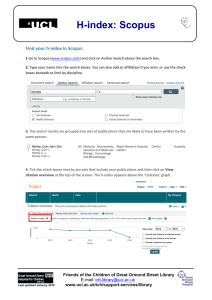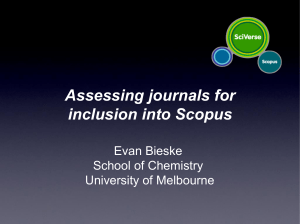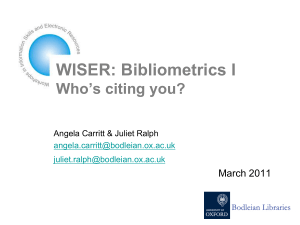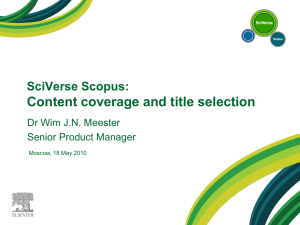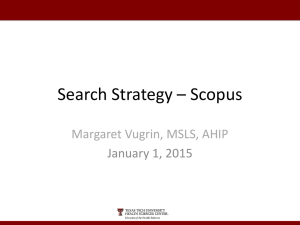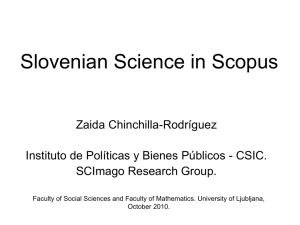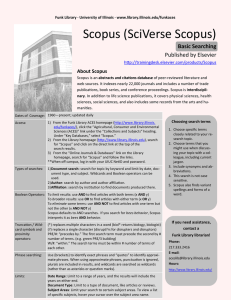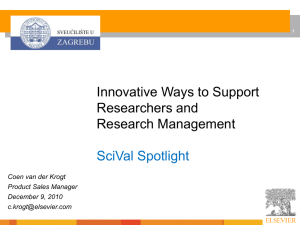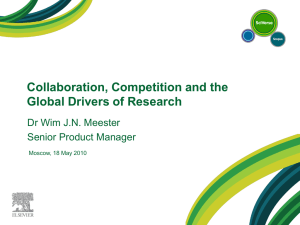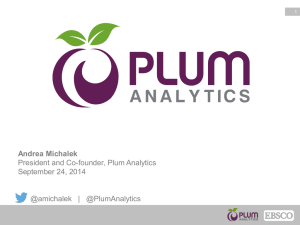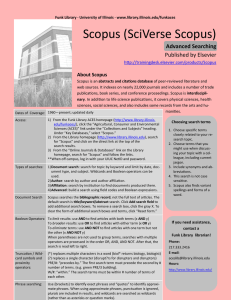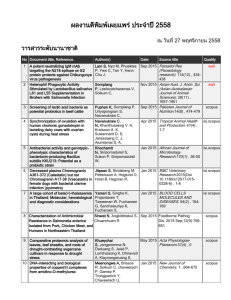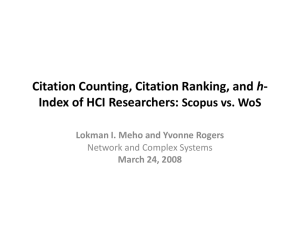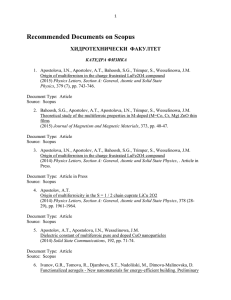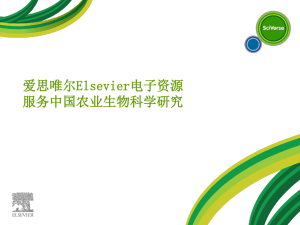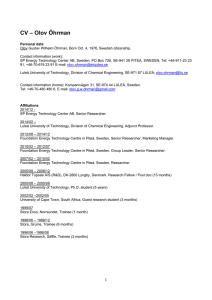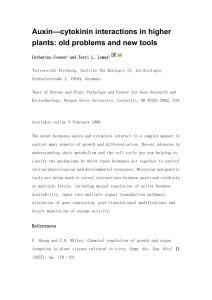Nick-Fowler-20101202
advertisement
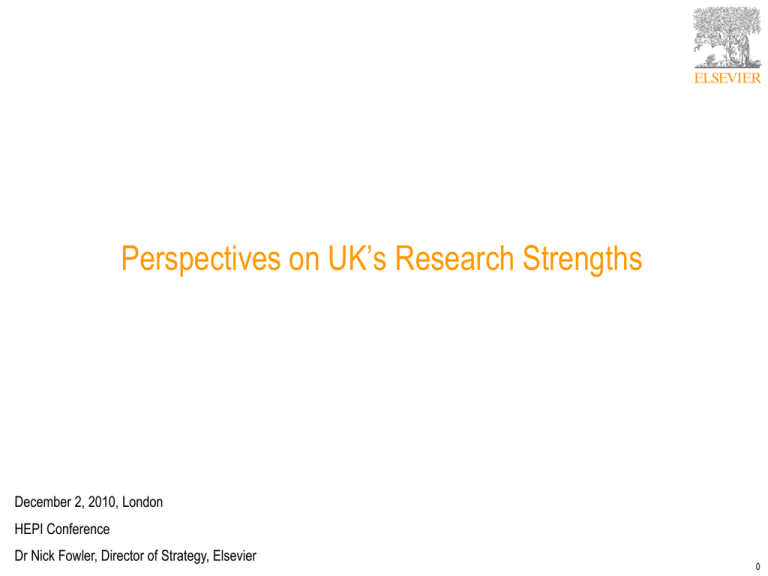
Perspectives on UK’s Research Strengths December 2, 2010, London HEPI Conference Dr Nick Fowler, Director of Strategy, Elsevier 0 Overview of Scientific, Technical and Medical (STM) Information industry Products Customers Other Databases and online tools Journals, print and E Books, print and E Source: Simba Individuals Academic and government institutions R&D-intensive corporations 1 Science publishers have a privileged vantage point on science Each year • 3 million articles submitted • 300,000 peer reviewers • 1.5 million articles published • 30 million readers • 2 billion digital article downloads • 30 million article citations 2 Publication impact, societal impact: Nobel prize examples 2010 Nobel Prize winner Idea Publication impact Societal impact IVF 44x average 4 million births Medicine Robert Edwards Physics Andrew Geim, Konstantin Novoslev Graphene 23x average Faster computers, lighter aeroplanes 3 Articles published UK, research articles published: 2003-2009 UK researchers authored 114,000+ articles in 2009 The number of articles authored by UK researchers grew on average by 3.3% per year from 2003-2009, vs. 4.0% globally Note: Data shows UK’s article outputs (research articles, reviews and conference papers) per year, 2003-09. Growth rates are CAGR calculated over the period 2003-09. Source: Scopus R&D funding inputs vs. published article outputs by country 1,000,000 Logarithmic scales United States log Articles 2008 Articles published, 2008 China 100,000 United Kingdom Germany Japan France Canada Italy Spain India Australia Korea Brazil Netherlands Russian Federation Switzerland Sweden Belgium Iran Denmark Israel Austria Greece Finland Czech RepublicNorway Mexico Hong Kong Portugal Singapore New Zealand Argentina Ireland South Africa Thailand Hungary Ukraine Romania Egypt Chile Malaysia Slovakia Pakistan Slovenia Croatia Bulgaria Serbia Tunisia Colombia Saudi Arabia Poland 10,000 Algeria Lithuania Estonia Indonesia Kuwait Philippines Uruguay Cyprus Iceland Peru Armenia Sri Lanka Ethiopia 1,000 Turkey Morocco Belarus 100 10 100 1,000 10,000 Gross Expenditure on R&D ($Millions) log GERD (million current PPP $) 100,000 1,000,000 5 Share of global R&D spending, 2006 and 2015 2015 2006 6 Global share of total articles published Share of published journal articles, 1996-2020 (projected) Year 7 UK, impact of research outputs: 2003-2008 International collaboration rate Size of bubble proportional to 5-year article output Citations per article UK articles are cited on average 5.8 times vs. 4.6 for the world average In terms of Impact, UK ‘punches above its weight’ UK’s growing publication impact is associated with growing levels of international collaboration Note: Data shows UK’s article outputs (research articles, reviews and conference papers) and shares using 5 year periods, e.g. 2008 corresponds to 2004-2008 publications . Source: Scopus 8 8 International collaboration rate UK research outputs: rates of collaboration rate Science is becoming more collaborative: the percent of articles co-authored by researchers residing in separate countries increased from 26% in 2003 to 33% in 2008 The UK’s rate of international collaboration is significantly higher: 41% of articles were co-authored with non-UK researchers in 2008 Note: Data shows proportion of article outputs representing international collaboration (where one or more other countries are listed in the author address) in 5-year periods, e.g. 2008 corresponds to 2004-2008 publications and 2004-2008 citations. 9 9 Source: Scopus Field-weighted relative impact International collaboration rates correlates strongly with publication impact 1 2 3 4 Number of collaborating countries (where 1 = domestic) 5 International scientific collaboration is generally acknowledged as a positive force driving national impact and prestige Domestic articles (‘1’) have no collaboration partners have around 3 times fewer citations per article than those with four collaborating countries (‘5’) Source: Scopus 10 10 UK: international collaboration Note: Collaboration relationships are shown for the UK and its local collaboration environment. Articles are counted in a 5-year window (i.e. 2004-08 citations to 2004-08 articles) and are represented as variablethickness lines (edges) between countries (nodes). Line thickness represents the share of collaboration to or from the connected countries. Lines are only shown where greater than 1,000 collaborative articles in this period. Visualisation is by the Force Atlas algorithm, which treats the network of edges as a system of interconnected springs and seeks to satisfy the tension of all edges simultaneously in a 2D rendering; hence, countries sharing a collaborative relationship tend to group together, while those that do not are placed further apart. 11 11 Source: Scopus Scientists are more mobile Destinations of researchers formerly affiliated with UK institutions Top destinations for UK-based researchers 1. 2. 3. 4. 5. 6. 7. 8. 9. 10. US Germany France Australia Canada Italy Netherlands Spain Japan China Source: Scopus 12 Map of UK research strengths, 2009 13 UK distinctive competency example Application of magnetic resonance imaging (MRI) technology in clinical neurophysiology Large, fast-growing area of research (20,000 articles in 2009); UK has 24% share, cites more recent research than the US Leading UK institutions: UCL, Oxford, Cambridge, Birmingham Most prolific author: from University of Birmingham Most prolific and most cited institution: UCL 14 UK distinctive competency example Acute Psychiatric Nursing Of all areas of research strength, UK leads by the greatest margin in Acute Psychiatric Nursing: 3x US articles, 2x US citations Leadership driven by King’s College London, City University, U. of Central Lancaster, U. of Manchester and U of Nottingham 15 UK distinctive competency example Climate change and sea levels UK slightly less prolific than US, but more highly cited. Leading institutions in the world include BAS, Oxford, Reading, Bristol and Durham Effective collaboration among UK researchers across disciplinary and institutional boundaries to create a national strength Example: second most highly cited article: physicists, computer scientists (Oxford), climate modellers (Met Office, Rutherford Appleton Laboratory), earth scientist (Open University), time-series analyst (LSE), meteorologist (U of Reading) 16 UK universities: volume vs impact of outputs Research Selective Field weighted relative citation index (2003-2007) 2.00 Research Intensive 1.80 1.60 1.40 1.20 World Average 1.00 0.80 Median FWRI per group Russell Group 1.50 94 Group 1.38 Others 0.87 0.60 0.40 0.20 RG 94G Others 0.00 0 1000 2000 3000 4000 Articles 2007 5000 6000 No UK university appears in more than 160 (40%) of UK’s distinctive research competencies Both Russell Group and non-Russell Group are highly cited relative to the world average Effective collaboration by UK researchers across all types of institutions at the level of highly specific sub-fields drives UK’s overall impact Source: Analysis based on Scopus data 7000 17 17 UK research strengths vs. other global leaders 18 Implications of observations are challenging Observations Challenges 1. R&D spending drives R&D outputs, and new • How to hold and grow share given global shift global leaders are emerging 2. Science is becoming more collaborative • How to find and build links with the right partners 3. Scientists are more mobile geographically • How to identify, attract and retain the best 4. Science is becoming more interdisciplinary • How to allocate funds across subjects and departments 19 Collaboration area (1 of 4): quality content to drive research efficiency Science information: less than 1% of universities’ spending, but drives the efficiency and effectiveness of the remaining 99% A 2x increase in article downloads is associated with a 3x increase in articles authored, a 2.7x increase in PhDs granted, and a 4x increase in grants won Effective research institutions drive societal and economic benefits Source: “E-journals, their use, value and impact”, 2009 RIN/Ciber 20 Collaboration area (2 of 4): enhanced access to scientific research data Very high importance , very high satisfaction High importance , low satisfaction Publishers are working to facilitate access to experimental data sets Link data sets to journal articles, e.g. Pangaea, CCDC Support and drive guidelines with key partners, e.g. Wellcome Trust, NSF, Bill and Melinda Gates Foundation Source: 3823 researcher respondents, PRC global access vs. Importance study http://www.publishingresearch.net/ 21 Collaboration area (3 of 4): amplified evidence to inform science policy + Example, the UCL/Lancet commission: 29 researchers, 13 UCL departments examined the Health Effects of Climate Change. Report was the most requested in Scopus of 7,500+ UCL-authored articles and was in the top 1% of most downloaded articles from ScienceDirect. Findings discussed at a meeting of commonwealth health ministers, and mentioned at the World Health Assembly Other Lancet commissions: the future of health and development with the LSHTM to coincide with the UN Summit held in New York; with UCL on Healthy Cities; with Harvard on the future of health professional education. 22 Collaboration area (4 of 4): tailored information to manage research impact Project to develop metrics and tools to help institutions maximise the impact of their research investments Institutional and national decision-making: needs data and analysis of collaboration networks, research strengths, and emerging hot spots of research 23 Summary Quality of life Quality research Quality information 24
